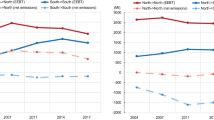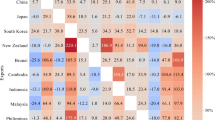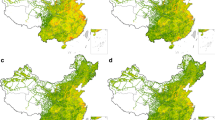Abstract
International trade has become the fastest growing driver of global carbon emissions, with large quantities of emissions embodied in exports from emerging economies. International trade with emerging economies poses a dilemma for climate and trade policy: to the extent emerging markets have comparative advantages in manufacturing, such trade is economically efficient and desirable. However, if carbon-intensive manufacturing in emerging countries such as China entails drastically more CO2 emissions than making the same product elsewhere, then trade increases global CO2 emissions. Here we show that the emissions embodied in Chinese exports, which are larger than the annual emissions of Japan or Germany, are primarily the result of China’s coal-based energy mix and the very high emissions intensity (emission per unit of economic value) in a few provinces and industry sectors. Exports from these provinces and sectors therefore represent targeted opportunities to address the climate–trade dilemma by either improving production technologies and decarbonizing the underlying energy systems or else reducing trade volumes.
This is a preview of subscription content, access via your institution
Access options
Subscribe to this journal
Receive 12 print issues and online access
$209.00 per year
only $17.42 per issue
Buy this article
- Purchase on Springer Link
- Instant access to full article PDF
Prices may be subject to local taxes which are calculated during checkout





Similar content being viewed by others
References
Kyoto Protocol to the United Nations Framework Convention on Climate Change (UNFCCC, 1997).
COP15 Copenhagen Accord (UNFCCC, 2009); http://unfccc.int/files/meetings/cop_15/application/pdf/cop15_cph_auv.pdf
Le Quéré, C. et al. The global carbon budget 1959–2011. Earth Syst. Sci. Data 5, 165–185 (2013).
Andres, R. J. et al. A synthesis of carbon dioxide emissions from fossil-fuel combustion. Biogeosciences 9, 1845–1871 (2012).
Raupach, M. R. et al. Global and regional drivers of accelerating CO2 emissions. Proc. Natl Acad. Sci. USA 104, 10288–10293 (2007).
Liu, Z. et al. A low-carbon road map for China. Nature 500, 143–145 (2013).
Weber, C. L., Peters, G. P., Guan, D. & Hubacek, K. The contribution of Chinese exports to climate change. Energy Policy 36, 3572–3577 (2008).
Feng, K. et al. Outsourcing CO2 within China. Proc. Natl Acad. Sci. USA 110, 11654–11659 (2013).
Le Quéré, C. et al. Global carbon budget 2014. Earth Syst. Sci. Data 7, 47–85 (2015).
Jakob, M. & Marschinski, R. Interpreting trade-related CO2 emission transfers. Nature Clim. Change 3, 19–23 (2013).
Minx, J. et al. A “Carbonizing Dragon”: China’s fast growing CO2 emissions revisited. Environ. Sci. Technol. 45, 9144–9153 (2011).
Guan, D., Peters, G. P., Weber, C. L. & Hubacek, K. Journey to world top emitter: An analysis of the driving forces of China’s recent CO2 emissions surge. Geophys. Res. Lett. 36, L04709 (2009).
Jiang, X. et al. Revealing the hidden health costs embodied in Chinese exports. Environ. Sci. Technol. 49, 4381–4388 (2015).
Liu, Z. China’s Carbon Emissions Report 2015 (Harvard Kennedy School, 2015).
Liu, Z., Geng, Y., Lindner, S. & Guan, D. Uncovering China’s greenhouse gas emission from regional and sectoral perspectives. Energy 45, 1059–1068 (2012).
Feng, K., Siu, Y. L., Guan, D. & Hubacek, K. Analyzing drivers of regional carbon dioxide emissions for China. J. Ind. Ecol. 16, 600–611 (2012).
Lindner, S., Liu, Z., Guan, D., Geng, Y. & Li, X. CO2 emissions from China’s power sector at the provincial level: Consumption versus production perspectives. Renew. Sustain. Energy Rev. 19, 164–172 (2013).
Liu, Z. et al. Embodied energy use in China’s industrial sectors. Energy Policy 49, 751–758 (2012).
Ang, B. W. The LMDI approach to decomposition analysis: A practical guide. Energy Policy 33, 867–871 (2005).
Friedlingstein, P. et al. Persistent growth of CO2 emissions and implications for reaching climate targets. Nature Geosci. 7, 709–715 (2014).
Liu, Z., Xi, F. & Guan, D. Climate negotiations: Tie carbon emissions to consumers. Nature 493, 304–305 (2013).
Davis, S. J., Peters, G. P. & Caldeira, K. The supply chain of CO2 emissions. Proc. Natl Acad. Sci. USA 108, 18554–18559 (2011).
Davis, S. J. & Caldeira, K. Consumption-based accounting of CO2 emissions. Proc. Natl Acad. Sci. USA 107, 5687–5692 (2010).
National Bureau of Statistics China Statistical Yearbook 2013 (China Statistics Press, 2013).
Yang, Y. & Suh, S. Environmental impacts of products in China. Environ. Sci. Technol. 45, 4102–4109 (2011).
Introduction to LCA with SimaPro 7 (PRé Consultants, 2008).
Yang, D., Liu, J., Yang, J. & Ding, N. Life-cycle assessment of China’s multi-crystalline silicon photovoltaic modules considering international trade. J. Cleaner Prod. 94, 35–45 (2015).
Liu, Z. et al. Climate policy: Steps to China’s carbon peak. Nature 522, 279–281 (2015).
Guan, D. et al. Determinants of stagnating carbon intensity in China. Nature Clim. Change 4, 1017–1023 (2014).
Liu, Z. et al. Reduced carbon emission estimates from fossil fuel combustion and cement production in China. Nature 524, 335–338 (2015).
IPCC 2006 IPCC Guidelines for National Greenhouse Gas Inventories Vol. 4 (IGES, 2006).
Feng, K., Hubacek, K., Pfister, S., Yu, Y. & Sun, L. Virtual scarce water in China. Environ. Sci. Technol. 48, 7704–7713 (2014).
Lenzen, M. et al. International trade of scarce water. Ecol. Econ. 94, 78–85 (2013).
Wiedmann, T. O. et al. The material footprint of nations. Proc. Natl Acad. Sci. USA 112, 6271–6276 (2015).
Lenzen, M. et al. International trade drives biodiversity threats in developing nations. Nature 486, 110–112 (2012).
Yu, Y., Feng, K. & Hubacek, K. Tele-connecting local consumption to global land use. Glob. Environ. Change 23, 1178–1186 (2013).
Weinzettel, J., Hertwich, E. G., Peters, G. P., Steen-Olsen, K. & Galli, A. Affluence drives the global displacement of land use. Glob. Environ. Change 23, 433–438 (2013).
Guan, D., Liu, Z., Geng, Y., Lindner, S. & Hubacek, K. The gigatonne gap in China’s carbon dioxide inventories. Nature Clim. Change 2, 672–675 (2012).
Narayanan, B. G., Aguiar, A. & Walmsley, T. L. Global Trade, Assistance, and Production: The GTAP 8 Data Base (Purdue University, 2012).
Liu, W. Theories and Practice of Constructing China’s Interregional Input–Output Tables between 30 Provinces in 2007 (Chinese Statistics Press, 2012).
Acknowledgements
This work was supported by China’s National Basic Research Program (2014CB441301), the State Key Laboratory of Urban and Regional Ecology, Chinese Academy of Sciences (SKLURE 2015-2-6), and Natural Science Foundation of China project (41328008). Z.L. acknowledges the National Natural Science Foundation of China-NSFC 41501605, the China Sustainable Energy Program of Energy Foundation (G-1407-21749), the Giorgio Ruffolo fellowship and the support from Italy’s Ministry for Environment, Land and Sea. S.J.D. acknowledges support from the Institute of Applied Ecology, Chinese Academy of Sciences Fellowships for Young International Distinguished Scientists. S.L. acknowledges the support of the Dow Sustainability Fellows Program. D.G. acknowledges the Economic and Social Research Council funded project ‘Dynamics of Green Growth in European and Chinese Cities’ (ES/L016028) and his Philip Leverhulme Prize.
Author information
Authors and Affiliations
Contributions
Z.L., K.F. and S.J.D. designed the research. Z.L., K.F. and S.J.D. conceived the paper. K.F. and J.L. provided the data. Z.L., S.J.D., K.F. and K.H. performed the analysis. S.J.D. drew the figures. All authors contributed to writing the paper.
Corresponding authors
Ethics declarations
Competing interests
The authors declare no competing financial interests.
Supplementary information
Rights and permissions
About this article
Cite this article
Liu, Z., Davis, S., Feng, K. et al. Targeted opportunities to address the climate–trade dilemma in China. Nature Clim Change 6, 201–206 (2016). https://doi.org/10.1038/nclimate2800
Received:
Accepted:
Published:
Issue Date:
DOI: https://doi.org/10.1038/nclimate2800
This article is cited by
-
Examining industrial air pollution embodied in trade: implications of a hypothetical China-UK FTA
Environment, Development and Sustainability (2023)
-
How can net petroleum importers achieve risk aversion in a globalized world: a multi-regional input–output perspective
Environmental Science and Pollution Research (2023)
-
How does export composition improvement affect carbon dioxide emissions in BRI countries? The mediating role of industrial structure upgrading and the moderating role of intellectual property protection
Environmental Science and Pollution Research (2023)
-
Near-real-time daily estimates of fossil fuel CO2 emissions from major high-emission cities in China
Scientific Data (2022)
-
The spatial characteristics of embodied carbon emission flow in Chinese provinces: a network-based perspective
Environmental Science and Pollution Research (2022)



